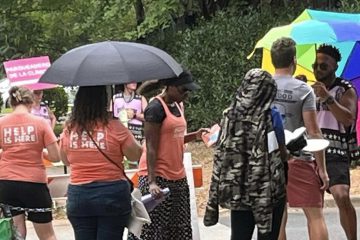Those of us who minister in front of abortion centers sometimes find the ways of the “old time” rescue ministries harsh, or not in sync with what we are doing nowadays. For example, I would not storm the abortion center or lie down in front of the door. However, that happened many times in the early days of prolife work. Many people who did so went to jail.
I do believe innocent babies are dying. However, I know I cannot snatch the babies out of the mothers’ wombs, thus I work within legal constraints. I minister with a perspective of influencing them to come and talk with me rather than employing tactics of civil disobedience and obstruction to prevent them from entering the abortion center.. I know if I can get them to talk with me, I have a better chance of convincing them not only to save their baby today, but to understand that abortion is evil and wrong before God.
Peaceful Resistance
Years ago, when the Roe v. Wade decision was handed down and abortion was allowed in our nation, ministries like Operation Rescue began. Many of the early leaders of those ministries were arrested. The ones I deeply admire were peaceful, but determined to block abortions. Please understand, I will never condone violence of any kind against the abortionist or the workers or the abortion center. Violence begets violence, and I do not think it is appropriate except in self defense. Having said that, the peaceful resistance of those early pro-life pioneers paved the way for us to be able to do what we do.
Personal Story
I personally know one of those early leaders, Pastor Flip Benham. Flip has gone to jail countless times for ignoring the unjust laws surrounding abortion. He has remained faithful to this mission for decades now. Flip was the one who befriended Norma McCorvey, the infamous Jane Roe of the Roe v. Wade decision. Ultimately, he led her to the Lord and baptized her. He became her lifelong friend.
He told me that when he went to jail, he always used it as an opportunity to minister to fellow cell mates. Flip worships God in any and all circumstances.
There are ways that Flip interacts with the pro-abortion crowd that I would not. I do not agree with everything he says nor all his suggestions in how we should approach ministry. But I deeply respect and honor him. He is an amazing man of God, and his motives are clearly to serve the Lord as well as he possibly can. He serves every day on the sidewalks of abortion centers, and has done so for decades.
I think it is very important for us to remember that these pioneers of the pro-life movement were unbelievably brave. They sacrificed everything to try to rescue babies. While many of us may feel they were too confrontational, they, in turn, feel that we are too soft in our current approach to ministry. After decades of them looking directly into the face of evil, I am not at all surprised or offended that they feel this way. Their way may not be my way, but I still very much respect who they are and what they have done.
Background of Pro-Life Ministry
Before ultrasound technology allowed us to see the unborn baby, abortion was allowed until quickening, or the time when a mother could first feel her child. Knowledge of the child before that time was limited and fed into a sense that abortion was not wrong until the child was clearly alive and moving in the mother’s womb (4-5 months). As medical understanding began to grow of the nature of the unborn baby, states began to regulate (and many outlawed) abortion. Women rights’ advocates cried out against the loss of what they viewed as a civil rights issue to be in control of their own bodies. The clamor rose to a national level, and ultimately resulted in the Roe v. Wade landmark decision.
The early pro-life groups were largely Catholic and the movement was small. After Roe v. Wade, pro-life activity exploded as evangelicals joined the movement. The fight to end abortion intensified. Large numbers of people now saw abortion as a terrible moral calamity, and began forming groups that knew the law was not going to bring about change. They began peaceful resistance, blockading abortion clinics and making it difficult for women to enter.
There was a dark, small group of extremists who resorted to violence. Their activity painted a picture of pro-life activism that was exaggerated and erroneous in depicting the movement as a whole. This excerpt below gives a sense of what the late 1980s and ’90s were like:
In the late 1970s and early 1980s, evangelical Christians joined the movement in great numbers, rejuvenating and eventually radicalizing the movement. Previously, in the late 1960s, evangelical scholars, pastors, and physicians could not agree on whether or not abortion was sinful. But by late 1970s and early 1980s, this sentiment had changed. Many evangelical laypeople and clergy opposed legal abortion and joined the fight to end it. Some simply joined existing pro-life groups; others formed new, more radical groups that rejected the politics of legislative reform. The most famous of the latter cohort was Operation Rescue, which sought to end abortion by “any means necessary.” Operation Rescue pioneered the pro-life “rescue,” in which thousands of activists created human blockades in front of clinics. In the 1980s and 1990s, Operation Rescue performed such rescues in cities across the nation, tying up the city’s police departments, filling local jails, and making it incredibly difficult to get an abortion. Their national media spectacle sought to attract reporters and stun the American public. Extremists in the movement went even further. Between the early 1980s and the 2000s, there were 153 assaults, 383 death threats, 3 kidnappings, 18 attempted murders, and 9 murders related to abortion providers.
Unfortunately, despite the fact that MOST pro-life activists were peaceful, the public perception was often based on the small group of extremists’ actions. It is easy to forget that the actions from groups like Operation Rescue brought the spiritual question of abortion as a terrible sin to the forefront of Christian attention. It galvanized the Church. Protection of unborn children became a conservative rallying cry, largely associated with the Republican Party. It ignited the movement to examine the important questions in addressing the abortion holocaust: When does life begin? When does human life become valuable? Who gives a human being value? Who has the right to take the life of unborn human beings? Is that a right that should be regulated or outright forbidden?
Implications for Sidewalk Ministry Now
First, I think we need to go out of our way to express our respect and appreciation of those who have gone before us. Second, when we encounter them on the sidewalk and they challenge what we do, we do not need to get involved in a long argument or even discussion about why we do things the way we do. We should thank them for their service and for their input. We should remember that they are the ones that fought for our constitutional right to free speech in front of abortion centers. They were the ones who suffered in jail rather than allow their rights to be trampled on and to fight for the unborn. They were the ones who so strongly brought the discussion about abortion into the open, and raised the relevant questions that would galvanize succeeding generations of believers to join the battle.
Learning about those early days gives us a greater appreciation of who the old guard pro-life advocates were and what they have done. It is easy to dismiss them, usually out of ignorance. Sometimes our perceptions are colored because of the extremists in the movement.
The more I learn of what they endured and why they endured it, the greater my respect grows. I also have a greater understanding of the suspicion and misperceptions many hold for prolife people in front of abortion centers.
I am grateful for those who had the courage to confront this issue when so few people were willing to take a stand.
“Stand therefore, having fastened on the belt of truth, and having put on the breastplate of righteousness, and, as shoes for your feet, having put on the readiness given by the gospel of peace” (Ephesians 6:14-15).


0 Comments